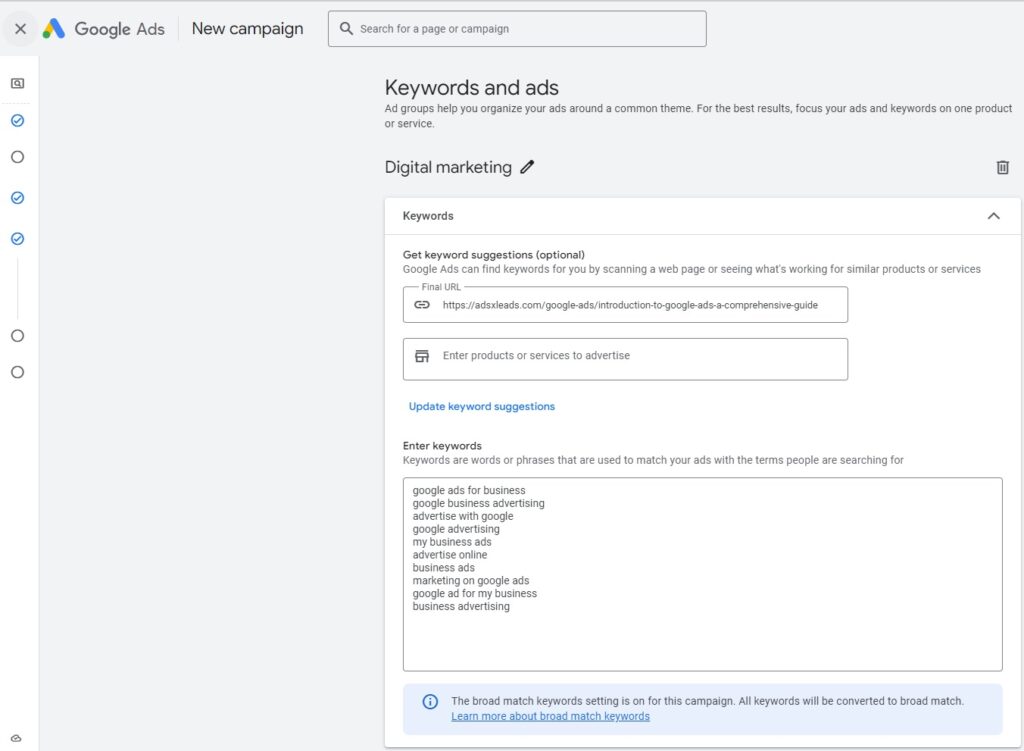Google Ads is the largest search advertising platform available, often outperforming organic search results. Studies show that Google Ads capture 65% of clicks for high-intent keywords, while organic results only account for 35% of those clicks.
Users are more than four times more likely to click on paid search ads on Google than on any other platform, with Google capturing 63% of clicks compared to Amazon’s 15%, YouTube’s 9%, and Bing’s 6%. This highlights the importance of not overlooking the Google Search Ads platform.
Still curious about what Google Search Ads are and how they function? Let’s explore further.
What do Google Search Ads look like?
Google’s Search Ads use a pay-per-click auction system where advertisers bid to have their ads appear in search results for specific keywords. When users enter a search query, the top ads appear above the organic results, providing enhanced visibility.
Components of Google Search Ads
Google Search Ads include the following elements:
- Landing Page Link: Directs users to the intended webpage when they click the ad.
- Headline: Split into two phrases and displayed in large blue font.
- Ad Copy: Consists of one or two descriptions.
- Optional Extensions: May include ratings, extra links, or phone numbers to increase the likelihood of user conversion.

Ad Placement and Visibility
High-intent keywords often result in three to five ads appearing at the top of search results, with the most relevant ads occupying the prime positions. As users scroll through multiple search pages, they encounter more ads. However, bidding on a keyword does not guarantee placement; it does, however, increase the likelihood of receiving some share of impressions.
Why Brands Use Google’s Search Ads
A significant 80% of brands running PPC campaigns focus on Google Ads, which deliver high conversion rates. But why is this the case?
Several compelling reasons exist:
- Connecting with High-Intent Buyers: Google Ads allows brands to reach customers actively searching for their products or services. For example, paying $2 for a click that could result in a $20, $200, or even $2,000 conversion is highly appealing.
- Enhanced Search Visibility: Google Ads provide an opportunity to appear at the top of search results, especially for competitive keywords where organic ranking is difficult. For instance, brands like Blueair and Honeywell can position their products at the top of Google’s search results for “air purifier,” even above the top organic result from the New York Times.
This strategic visibility is crucial for brands aiming to capture high-intent traffic and drive conversions.
The cost is also competitive. Even though some other PPC platforms are less expensive, the price you end up paying will change based on the competitiveness of the keyword and your own bid. You only have to pay for the click on some keywords, which can cost less than $1. Even though there is no guarantee of a conversion from a click, it is still better than paying for an ad placement alone.
Finally, Google Ads is approachable and accessible. You get to decide how much you want to spend on each click and how much you can afford to spend overall, even though it can get pricey. Additionally, there are not many obstacles to entry, and the system is, at least initially, fairly simple to learn.
How Do Google Search Ads Work?
With Google Search Ads, advertisers participate in an auction system where they bid on keywords. You are in direct competition with the advertisers who are placing bids on the same keywords as you. This makes keyword research essential.
Your campaigns should ideally be segmented according to the keywords you’re targeting, allowing you to create relevant copy that is most likely to drive clicks. Ads that are highly relevant and have the most relevant landing pages will receive higher quality scores, leading to more placements, better rankings, and lower costs.
Many brands offer a variety of products and services, which should be reflected in your keywords.

For example, an electrician will want to target broad terms like “Denver electrician” and “Denver electrician licensed and insured.” Additionally, targeting specific services such as “install recessed lights,” “rewiring,” and “install new outlets” will capture users searching for those particular services.
You create Google Search Ads through Google’s self-serve ad platform, which is free to join and create an account. The only cost is for the clicks on an ad that’s running.
Although creating Google Ads is simple in its basic form, you can also use more sophisticated methods, like:
- Extensions to enhance your ad.
- Dynamic keyword insertion will automatically make your ad more relevant.
- Automated rules for streamlined campaign management.
Closing Remarks
Google Search Ads are a significant part of what we help our clients with because they can drive substantial customer engagement, sales, and profit. You can scale ad campaigns up or down to fit your business and budget, providing great control over your spending and what you’re willing to invest in.
Throughout this Hub series, we’re going to explore everything you need to know about Google Search Ads, including how the search network works, how to create effective Search Ads, and more.
